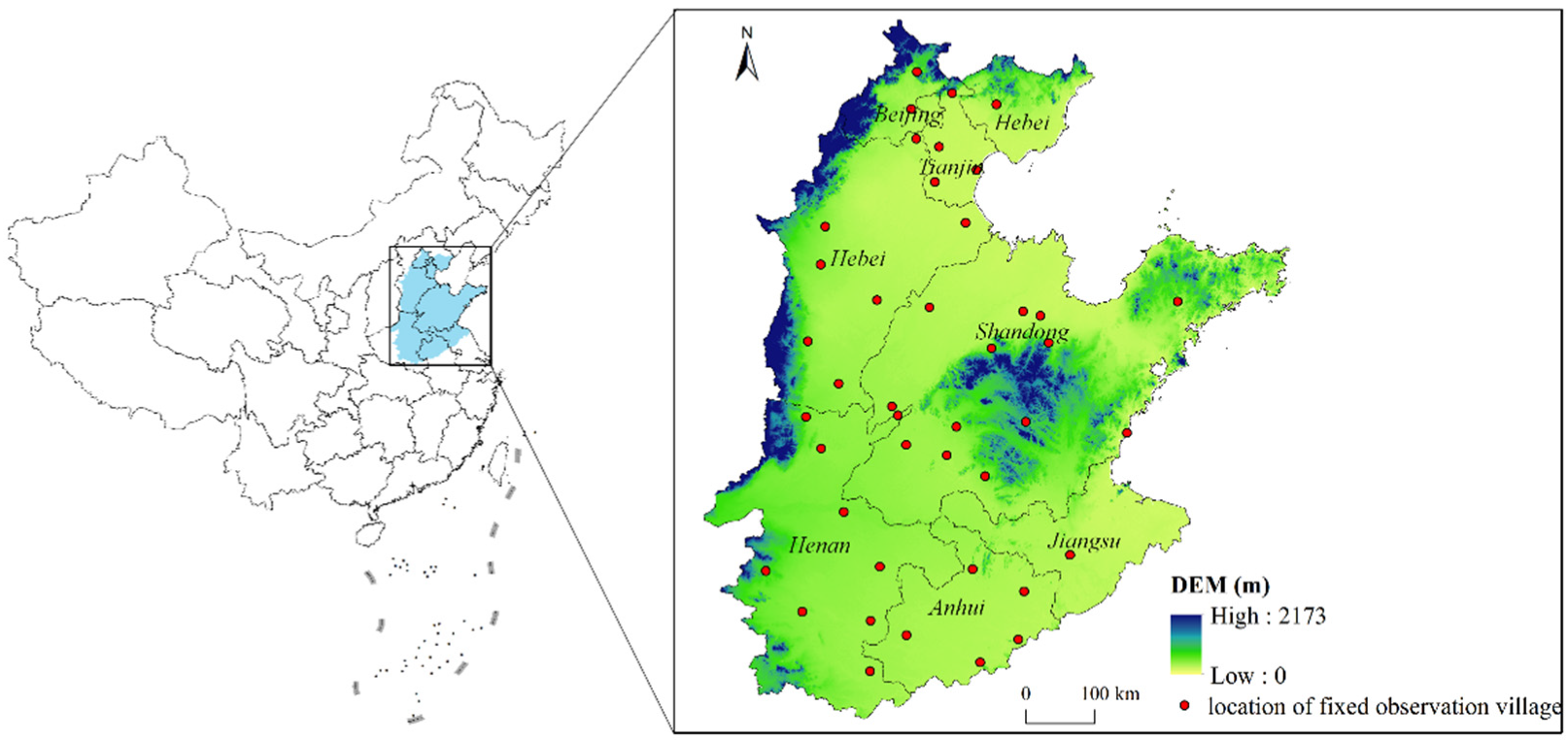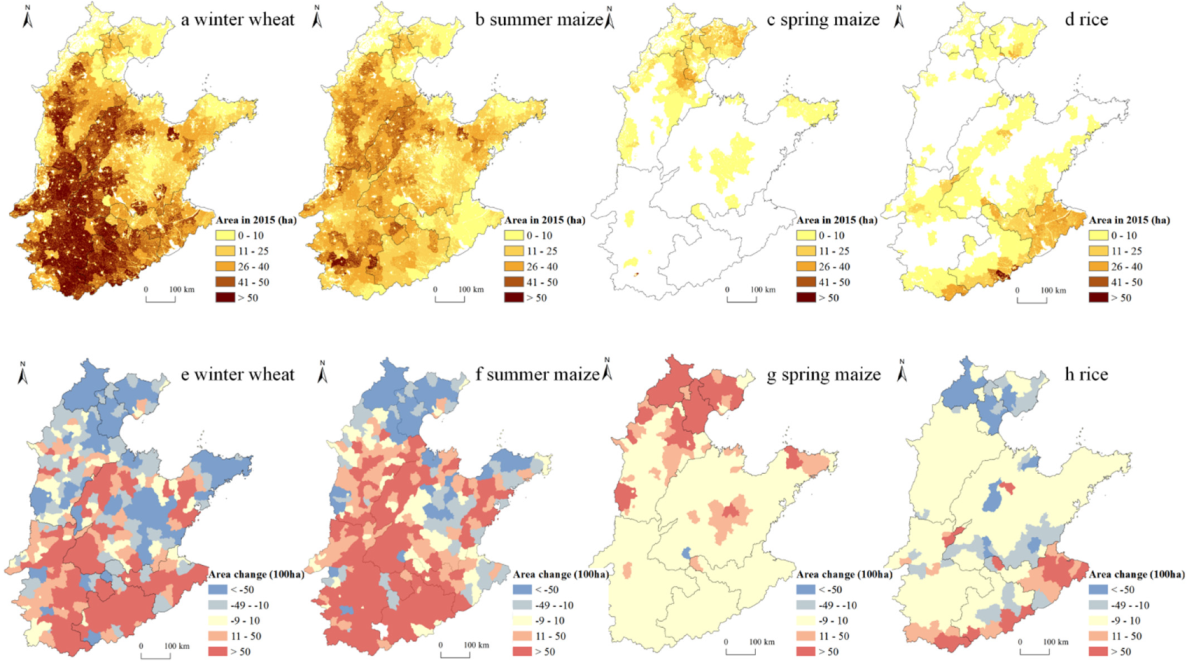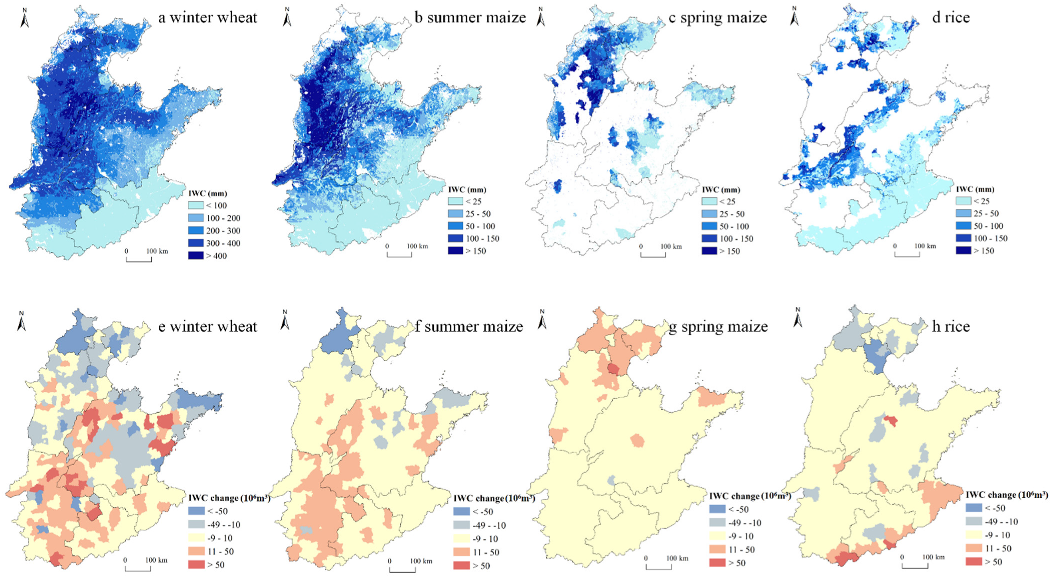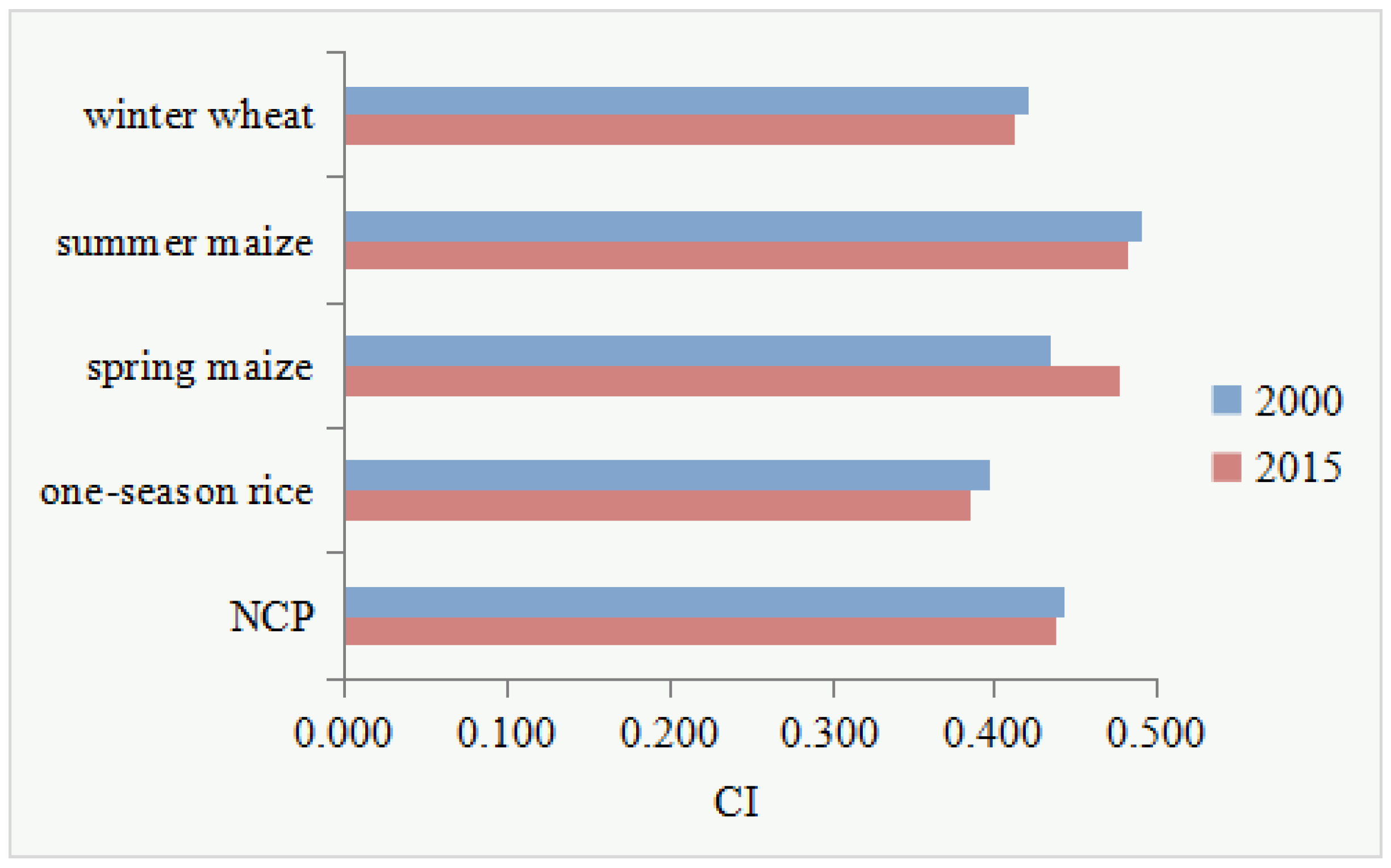Changes in the Water-Energy Coupling Relationship in Grain Production: A Case Study of the North China Plain
Abstract
:1. Introduction
2. Materials and Methods
2.1. Study Area
2.2. Data Source and Preprocessing
2.3. IWC of Grain Crops at the Pixel Level
2.4. EC of Grain Crops at the Pixel Level
2.5. Coupling Index of IWC and EC of Grain Crops at the Pixel Level
3. Results
3.1. Changes in Grain Planting Structure in the NCP
3.2. Changes in IWC and EC for Grain Production in the NCP
3.3. Changes in the Coupling Relationship of IWC and EC for Grain Production in the NCP
4. Discussion
5. Conclusions
Author Contributions
Funding
Institutional Review Board Statement
Informed Consent Statement
Conflicts of Interest
References
- Huang, J.; Ridoutt, B.G.; Sun, Z.; Lan, K.; Thorp, K.R.; Wang, X.; Yin, X.; Huang, J.; Chen, F.; Scherer, L. Balancing food production within the planetary water boundary. J. Clean. Prod. 2020, 253, 119900. [Google Scholar] [CrossRef]
- FAO. The State of the World’s Land and Water Resources for Food and Agriculture (SOLAW): Managing Systems at Risk; Earthscan: London, UK, 2011. [Google Scholar]
- FAO. Energy-Smart Food for People and Climate: Issue Paper; Food and Agriculture Organization of the United Nations: Rome, Italy, 2011. [Google Scholar]
- FAO. The Water Energy Food Nexus: A New Approach in Support of Food Security and Sustainable Agriculture; Food and Agriculture Organization of the United Nations: Rome, Italy, 2014. [Google Scholar]
- Zuo, L.; Zhang, Z.; Carlson, K.M.; MacDonald, G.K.; Brauman, K.A.; Liu, Y.; Zhang, W.; Zhang, H.; Wu, W.; Zhao, X.; et al. Progress towards sustainable intensification in China challenged by land-use change. Nat. Sustain. 2018, 1, 304–313. [Google Scholar] [CrossRef]
- Huai, H.; Chen, X.; Huang, J.; Chen, F. Water-Scarcity Footprint Associated with Crop Expansion in Northeast China: A Case Study Based on AquaCrop Modeling. Water 2019, 12, 125. [Google Scholar] [CrossRef] [Green Version]
- Smidt, S.J.; Haacker, E.M.; Kendall, A.D.; Deines, J.M.; Pei, L.; Cotterman, K.A.; Li, H.; Liu, X.; Basso, B.; Hyndman, D.W. Complex water management in modern agriculture: Trends in the water-energy-food nexus over the High Plains Aquifer. Sci. Total Environ. 2016, 566–567, 988–1001. [Google Scholar] [CrossRef] [PubMed] [Green Version]
- Newell, J.P.; Goldstein, B.; Foster, A. A 40-year review of food–energy–water nexus literature and its application to the urban scale. Environ. Res. Lett. 2019, 14, 073003. [Google Scholar] [CrossRef] [Green Version]
- Ko, J.; Piccinni, G.; Steglich, E. Using EPIC model to manage irrigated cotton and maize. Agric. Water Manag. 2009, 96, 1323–1331. [Google Scholar] [CrossRef]
- Xu, H.; Tian, Z.; He, X.; Wang, J.; Sun, L.; Fischer, G.; Fan, D.; Zhong, H.; Wu, W.; Pope, E.; et al. Future increases in irrigation water requirement challenge the water-food nexus in the northeast farming region of China. Agric. Water Manag. 2019, 213, 594–604. [Google Scholar] [CrossRef]
- Schaldach, R.; Koch, J.; Aus der Beek, T.; Kynast, E.; Flörke, M. Current and future irrigation water requirements in pan-Europe: An integrated analysis of socio-economic and climate scenarios. Glob. Planet. Change 2012, 94–95, 33–45. [Google Scholar] [CrossRef]
- Konar, M.; Hussein, Z.; Hanasaki, N.; Mauzerall, D.L.; Rodriguez-Iturbe, I. Virtual water trade flows and savings under climate change. Hydrol. Earth Syst. Sci. Discuss. 2013, 10, 67–101. [Google Scholar] [CrossRef] [Green Version]
- Cao, X.; Zeng, W.; Wu, M.; Li, T.; Chen, S.; Wang, W. Water resources efficiency assessment in crop production from the perspective of water footprint. J. Clean. Prod. 2021, 309, 127371. [Google Scholar] [CrossRef]
- Suttayakul, P.; H-Kittikun, A.; Suksaroj, C.; Mungkalasiri, J.; Wisansuwannakorn, R.; Musikavong, C. Water footprints of products of oil palm plantations and palm oil mills in Thailand. Sci. Total Environ. 2016, 542, 521–529. [Google Scholar] [CrossRef] [PubMed]
- Scarpare, F.V.; Hernandes, T.A.D.; Ruiz-Corrêa, S.T.; Kolln, O.T.; Gava, G.J.d.C.; dos Santos, L.N.S.; Victoria, R.L. Sugarcane water footprint under different management practices in Brazil: Tietê/Jacaré watershed assessment. J. Clean. Prod. 2016, 112, 4576–4584. [Google Scholar]
- Liu, J.; Zehnder, A.J.B.; Yang, H. Global consumptive water use for crop production: The importance of green water and virtual water. Water Resour. Res. 2009, 45, W05428. [Google Scholar] [CrossRef] [Green Version]
- Boone, L.; Van Linden, V.; De Meester, S.; Vandecasteele, B.; Muylle, H.; Roldán-Ruiz, I.; Nemecek, T.; Dewulf, J. Environmental life cycle assessment of grain maize production: An analysis of factors causing variability. Sci. Total Environ. 2016, 553, 551–564. [Google Scholar] [CrossRef]
- Wang, C.; Li, X.; Gong, T.; Zhang, H. Life cycle assessment of wheat-maize rotation system emphasizing high crop yield and high resource use efficiency in Quzhou County. J. Clean. Prod. 2014, 68, 56–63. [Google Scholar] [CrossRef]
- Taki, M.; Soheili-Fard, F.; Rohani, A.; Chen, G.; Yildizhan, H. Life cycle assessment to compare the environmental impacts of different wheat production systems. J. Clean. Prod. 2018, 197, 195–207. [Google Scholar] [CrossRef] [Green Version]
- He, X.; Qiao, Y.; Liang, L.; Knudsen, M.T.; Martin, F. Environmental life cycle assessment of long-term organic rice production in subtropical China. J. Clean. Prod. 2018, 176, 880–888. [Google Scholar] [CrossRef]
- Zhai, Y.; Zhang, T.; Bai, Y.; Ji, C.; Ma, X.; Shen, X.; Hong, J. Energy and water footprints of cereal production in China. Resour. Conserv. Recycl. 2021, 164, 105150. [Google Scholar] [CrossRef]
- Kan, Z.-R.; Liu, Q.-Y.; He, C.; Jing, Z.-H.; Virk, A.L.; Qi, J.-Y.; Zhao, X.; Zhang, H.-L. Responses of grain yield and water use efficiency of winter wheat to tillage in the North China Plain. Field Crops Res. 2020, 249, 107760. [Google Scholar] [CrossRef]
- Li, P.; Ren, L. Evaluating the effects of limited irrigation on crop water productivity and reducing deep groundwater exploitation in the North China Plain using an agro-hydrological model: II. Scenario simulation and analysis. J. Hydrol. 2019, 574, 715–732. [Google Scholar] [CrossRef]
- Gleeson, T.; Wada, Y.; Bierkens, M.F.P.; van Beek, L.P.H. Water balance of global aquifers revealed by groundwater footprint. Nature 2012, 488, 197–200. [Google Scholar] [CrossRef] [PubMed]
- Wang, X.; Li, X.; Fischer, G.; Sun, L.; Tan, M.; Xin, L.; Liang, Z. Impact of the changing area sown to winter wheat on crop water footprint in the North China Plain. Ecol. Indic. 2015, 57, 100–109. [Google Scholar] [CrossRef]
- Zhong, H.; Sun, L.; Fischer, G.; Tian, Z.; van Velthuizen, H.; Liang, Z. Mission Impossible? Maintaining regional grain production level and recovering local groundwater table by cropping system adaptation across the North China Plain. Agric. Water Manag. 2017, 193, 1–12. [Google Scholar] [CrossRef]
- Wang, X.; Li, X. Irrigation Water Availability and Winter Wheat Abandonment in the North China Plain (NCP): Findings from a Case Study in Cangxian County of Hebei Province. Sustainability 2018, 10, 354. [Google Scholar] [CrossRef] [Green Version]
- Monfreda, C.; Ramankutty, N.; Foley, J.A. Farming the planet: 2. Geographic distribution of crop areas, yields, physiological types, and net primary production in the year 2000. Glob. Biogeochem. Cycles 2008, 22. [Google Scholar] [CrossRef]
- Portmann, F.T.; Siebert, S.; Döll, P. MIRCA2000-Global monthly irrigated and rainfed crop areas around the year 2000: A new high-resolution data set for agricultural and hydrological modeling. Glob. Biogeochem. Cycles 2010, 24, GB1011. [Google Scholar] [CrossRef]
- Office of the rural fixed observation point system. Compilation of Survay Data of Rural Fixed Observation Villages; China Agriculture Press: Beijing, China, 2015. [Google Scholar]
- Wang, Y.; Li, X.; Xin, L.; Tan, M.; Jiang, M. Spatiotemporal changes in Chinese land circulation between 2003 and 2013. J. Geogr. Sci. 2018, 28, 707–724. [Google Scholar] [CrossRef] [Green Version]
- Tian, Z.; Ji, Y.; Xu, H.; Qiu, H.; Sun, L.; Zhong, H.; Liu, J. The potential contribution of growing rapeseed in winter fallow fields across Yangtze River Basin to energy and food security in China. Resour. Conserv. Recycl. 2021, 164, 105159. [Google Scholar] [CrossRef]
- Wang, X.; Xin, L.; Tan, M.; Li, X.; Wang, J. Impact of spatiotemporal change of cultivated land on food-water relations in China during 1990–2015. Sci. Total Environ. 2020, 716, 137119. [Google Scholar] [CrossRef] [PubMed]
- Tian, Z.; Zhong, H.; Shi, R.; Sun, L.; Fischer, G.; Liang, Z. Estimating potential yield of wheat production in China based on cross-scale data-model fusion. Front. Earth Sci. 2012, 6, 364–372. [Google Scholar] [CrossRef]
- IIASA/FAO. Global Agro-Ecological Zones (GAEZ v3.0); IIASA: Laxenburg, Austria; FAO: Rome, Italy, 2012. [Google Scholar]
- Xu, J. A Study on the Energy Use and Energy Efficiency of Garin Production: Empirical Analysis Based on DEA; Zhejiang University: Hangzhou, China, 2011. [Google Scholar]
- Zhen, W.; Qin, Q.; Wei, Y.-M. Spatio-temporal patterns of energy consumption-related GHG emissions in China’s crop production systems. Energy Policy 2017, 104, 274–284. [Google Scholar] [CrossRef]
- Yuan, S.; Peng, S. Trends in the economic return on energy use and energy use efficiency in China’s crop production. Renew. Sustain. Energy Rev. 2017, 70, 836–844. [Google Scholar] [CrossRef]
- Yan, H.; Liu, J.; Huang, H.Q.; Tao, B.; Cao, M. Assessing the consequence of land use change on agricultural productivity in China. Glob. Planet. Change 2009, 67, 13–19. [Google Scholar] [CrossRef]
- Yan, H.; Ji, Y.; Liu, J.; Liu, F.; Hu, Y.; Kuang, W. Potential promoted productivity and spatial patterns of medium- and low-yield cropland land in China. J. Geogr. Sci. 2016, 26, 259–271. [Google Scholar] [CrossRef] [Green Version]
- Li, Y.; Li, Y.; Zhou, Y.; Shi, Y.; Zhu, X. Investigation of a coupling model of coordination between urbanization and the environment. J. Environ. Manag. 2012, 98, 127–133. [Google Scholar] [CrossRef]
- Ti, J.; Yang, Y.; Pu, L.; Wen, X.; Yin, X.; Chen, F. Ecological compensation for winter wheat fallow and impact assessment of winter fallow on water sustainability and food security on the North China Plain. J. Clean. Prod. 2021, 328, 129431. [Google Scholar] [CrossRef]
- Cheng, H.; Xie, H. Impact of Wheat Price Changes on Farmers’ Willingness to Participate in Fallow. J. Resour. Ecol. 2020, 11, 589–597. [Google Scholar]
- Kong, X.; Lal, R.; Li, B.; Liu, H.; Li, K.; Feng, G.; Zhang, Q.; Zhang, B. Fertilizer Intensification and Its Impacts in China’s HHH Plains. Adv. Agron. 2014, 125, 135–169. [Google Scholar]
- Liu, Y.; Song, W.; Deng, X. Changes in crop type distribution in Zhangye City of the Heihe River Basin, China. Appl. Geogr. 2016, 76, 22–36. [Google Scholar] [CrossRef]







Publisher’s Note: MDPI stays neutral with regard to jurisdictional claims in published maps and institutional affiliations. |
© 2022 by the authors. Licensee MDPI, Basel, Switzerland. This article is an open access article distributed under the terms and conditions of the Creative Commons Attribution (CC BY) license (https://creativecommons.org/licenses/by/4.0/).
Share and Cite
Wang, X.; Li, X.; Xiao, X.; Fan, L.; Zuo, L. Changes in the Water-Energy Coupling Relationship in Grain Production: A Case Study of the North China Plain. Int. J. Environ. Res. Public Health 2022, 19, 9527. https://doi.org/10.3390/ijerph19159527
Wang X, Li X, Xiao X, Fan L, Zuo L. Changes in the Water-Energy Coupling Relationship in Grain Production: A Case Study of the North China Plain. International Journal of Environmental Research and Public Health. 2022; 19(15):9527. https://doi.org/10.3390/ijerph19159527
Chicago/Turabian StyleWang, Xue, Xiubin Li, Xingyuan Xiao, Limeng Fan, and Lijun Zuo. 2022. "Changes in the Water-Energy Coupling Relationship in Grain Production: A Case Study of the North China Plain" International Journal of Environmental Research and Public Health 19, no. 15: 9527. https://doi.org/10.3390/ijerph19159527
APA StyleWang, X., Li, X., Xiao, X., Fan, L., & Zuo, L. (2022). Changes in the Water-Energy Coupling Relationship in Grain Production: A Case Study of the North China Plain. International Journal of Environmental Research and Public Health, 19(15), 9527. https://doi.org/10.3390/ijerph19159527








